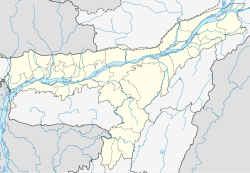Haflong
|
Haflong হাফলং |
|
|---|---|
| Town | |
| Nickname(s): Switzwerland of northeast, India | |
| Coordinates: 25°10′08″N 93°00′58″E / 25.169°N 93.016°ECoordinates: 25°10′08″N 93°00′58″E / 25.169°N 93.016°E | |
| Country |
|
| State | Assam |
| District | Dima Hasao previous N.C.Hills |
| Government | |
| • Body | Haflong Town Committee |
| Area | |
| • Total | 12.79 km2 (4.94 sq mi) |
| Elevation | 966.216 m (3,170.000 ft) |
| Population (2012) | |
| • Total | 43,756 |
| • Density | 3,400/km2 (8,900/sq mi) |
| Languages | |
| • Official English | Haflong Hindi language, Dimasa language |
| Time zone | IST (UTC+5:30) |
| PIN | 788819 |
| Telephone code | 03673 |
| ISO 3166 code | IN-AS |
| Vehicle registration | AS |
Haflong (Assamese: হাফলং) is a town and headquarters of Dima Hasao in India in the state of Assam. It is the only hill station in Assam.Haflong has been derieved from the Dimasa language meaning "Ant hill".
Haflong is located at Coord |25.18|N|9E. It has an average elevation of 966.216 metres (3170 feet).
Haflong has a humid subtropical climate (Köppen climate classification Cwa), falling just short of a tropical savanna climate (Köppen climate classification Aw).
The lowest temperature ever recorded was 2.4°C on January 7, 1980.
As of 2012 the India census, Haflong had a population of 43,756. Males constitute 45% of the population and females 55%. Haflong has an average literacy rate of 92%, higher than the national average of 59.5%: male literacy is 85%, and female literacy is 75%. In Haflong, 12% of the population is under 6 years of age. The population of the Town comprises various tribes & races who maintain their own dialect, culture, customs & usages. Apart from various tribes (Oriental Indians), non-tribals also account for a sizable amount of the population. They are mostly government employees, traders living in urban & semi-urban area. The small and serene Town shelter the lovely people – warm and fascinating – and as colourful as the land itself. It is also the home of various tribes: Dimasa, Nagas, Hmar, Kukis, Mizo, Bengali, Assamese, Gorkha, Biate and Hrangkhol.
...
Wikipedia


